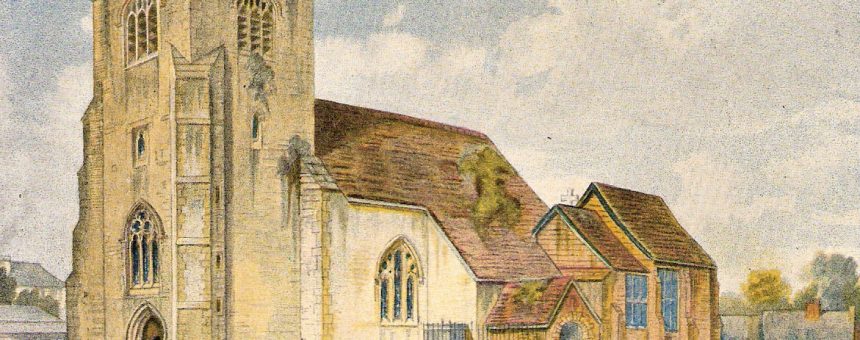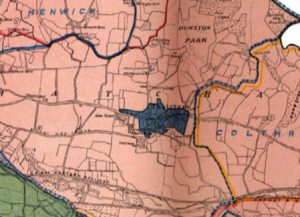I am always being asked the question “What is the oldest building in Thatcham?” So first a clarification, typically the person asking is referring to standing building and not those already destroyed. Thus in this article I am ignoring buildings that are no longer standing such as Chamberhouse Castle but will revisit them in a future post.
People typically assume the Church or the Old Bluecoat School are the oldest. So which is it? I thought it might be of interest in this article to go through a small number of the old buildings in Thatcham.
St Mary’s Church
The present church was previously known as St Luke’s, see my earlier post on the topic here, is thought to have been erected c.1141, replacing an earlier Saxon Church. This is around the time that the Manor of Thatcham was granted to Reading Abbey by King henry I. However it is not the church you see today that was erected but rather just a small, 66 feet by 21 feet, rectangular building, essentially what is today Nave. The church was then extended with a Chancel, later north and south isle, a tower and then in 1857 the whole building was renovated. Ignoring this and accepting that some of the original building still exists, however little it might be, part of the building are the oldest in Thatcham.
The Chapel of the Borough
The chapel is the only grade I listed building in Thatcham. Around 1300 Anthony de Bradeney was the rector of Thatcham. He also served Bath and Wells and was often absent from Thatcham. One theory is this may have influenced the creation of a new Chapel, another says it could have been to mark the new borough status and a third says it was the growing size of the community.
The exact reason for the building of the chapel needs more research but whatever the reason for creating the chapel, it was placed right on the edge of the eastern boundary of the Borough whilst St Mary’s was immediately outside. The boundary is shown as the blue area in the map below. It is said parishioners shortly after 1301 had the chapel built and Sir Richard de Fokerham, Lord of the Manor of Colthrop, obtained permission for services to be held, granted in 1304.
A deed from 1446 notes St Thomas the Martyr and so we assume this was St Thomas’ Chapel or the Chapel of the Borough. It was in use until mid 1500s as a place of worship after which it appears to have stood unused. That is until the start of the 18thcentury when Lady Frances Winchcombe, wife of Sir Henry Winchcombe, gave 1/2acre of land in Chapel Street with old decayed Chapel for it to be converted to a school for education of 30 poor boys. There is plenty more history to the building but we know from this short account it has stood since c.1304 and although renovated several times since 1707 much of the original, the stonework for example, dates to the construction.
The Grange
The Grange was part of Thatcham Farm until the 20th Century when the farm was sold off, parts into offices others into housing. The suggestion is that the barn itself is possibly 16th century, other buildings connected to the farm are later.
The listed building entry for The Grange notes a 17th century building largely based on the fish style tile hanging. However some of the local historians and a visit from an archeological company suggest that parts of the building, going from some of the exposed wood, may be 14th century thus possibly making it Medieval and contemporary with The Chapel of the Borough.
The building has been constructed in at least three main phases with the oldest being in the centre. More research and dating is needed to be done to clarify the true history of the building. It is agreed on by most though that the Eastern side is an 18th century addition and the western side is 19th and 20th century extensions.
Monks Chambers
It is thought this building was erected in c.1540, is timber framed and probably built with wattle and daub infill although some has been replaced with brick. Until c.1900 this was four cottages, this was altered to two cottages and later one. Thus inside there is evidence of stairways and doorways from an earlier time. It is thought the name derives from monks that once stayed on the site whilst visiting the area. It is possible this was when the Church was connected with Reading Abbey. Again more research is required but there is little doubt the building dates to at least c.1540.
A summary
This is just a small selection of the historical buildings. I will write about more buildings in future posts but just to give you a taste of what is to come, there is the New Inn, the building dating to the 16th century. Rooftops, 17 Chapel Street, the core of which is again a 16th century structure. And although outside the present Thatcham boundary, there is Old Henwick Cottage (Henwick Old Cottage, Henwick Farm, Henwick Old Farm, Northway’s Farm, etc.), which was originally part of Thatcham. Many of these need further research, paper based is one but inspection is another and testing timbers is another. All are costly and time consuming but are going to be needed if we are to find the true history of these structures.
To answer the original question, the church has the oldest elements, the Chapel of the Borough (the Old Bluecoat School) would be next but the Grange would be a close third place.




